|
Die Schlacht Von
Bullenkopf
an
after action report of the game held 17th - 18th
November 2001
by
Peter Hunt
The History
In
an alternative 1813 Archduke Charles of
Austria
came out of retirement to lead the struggle against
Napoleon. The French Army of
Germany was well dispersed but Napoleon kept under his personal command the
Infantry of the Imperial Guard, a Reserve Cavalry corps, a line infantry
corps of Poles and Frenchmen and the Saxon contingent with a division each
of horse and foot. Just as at
Lautzen and
Bautzen
the Emperor was hampered by his lack of scouting cavalry
and so it was to the surprise of all concerned that Napoleon and Charles
blundered into each other in a meeting engagement on the rolling Saxon
countryside near the small town of
Bullenkopf. Charles’ forces were of a similar size to the
Emperor’s: an Austrian corps of three divisions, a Prussian corps of two
divisions, a reserve cavalry division and an under strength grenadier
division.
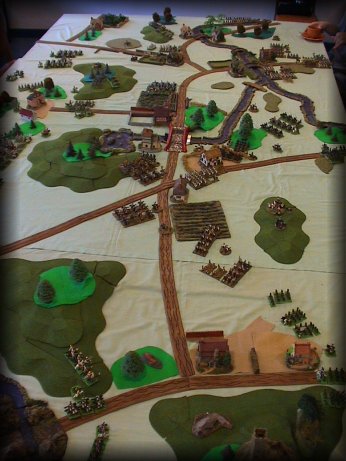 The
terrain was unremarkable. Over a
space of three miles by one and a half miles a series of gentle, often
wooded, hills broke the field into four main areas. From
the French right two wooded hills gave way to a wide valley on the other
side of which was a series of hills, woods, ponds and villages that made up
the centre of the position. The
left was dominated by a stream about a mile from the French positions with
woods, hills and villages on both banks. The
terrain was unremarkable. Over a
space of three miles by one and a half miles a series of gentle, often
wooded, hills broke the field into four main areas. From
the French right two wooded hills gave way to a wide valley on the other
side of which was a series of hills, woods, ponds and villages that made up
the centre of the position. The
left was dominated by a stream about a mile from the French positions with
woods, hills and villages on both banks.
From
6AM
both sides started warily deploying into the battle
area. Both Napoleon and Charles
were concerned about their flanks and kept almost a quarter of their forces
deployed outside the battlefield to prevent the other outflanking them. The
two played a cat and mouse game of bluff and counterbluff trying to get
territorial advantage without committing themselves outright. Then,
just before
9AM
, Napoleon quickly pulled in his Reserve Cavalry, which
had been outside the field protecting his flanks, and massed them in his
centre. Thus, at one stroke, the
Emperor had achieved numerical superiority on the field and the battle was
on.
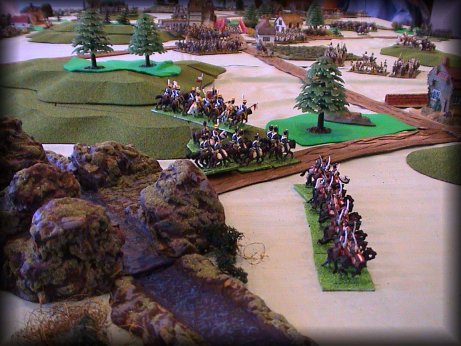 The
Emperor had positioned the Poles on his right flank with the French
infantry, and dragoons of the Reserve Cavalry covering the valley. Opposite
them were one Prussian division and the Austrian Reserve Cavalry.
Half of the Saxon foot made up the French centre with the French
elite heavy cavalry behind them. Then
came the Imperial Guard. One Austrian and one Prussian division faced this
sector. The remainder of the
Saxon infantry and the Saxon horse covered the French left, faced by one
Austrian division and a brigade from one of the Austrian divisions further
out on the flank, off the battlefield. Neither
side’s deployments were perfect. The French infantry on the right was
stretched out very thinly over a mile and a half, and half of the Saxons
were separated from their main body. On
the Allied side although their divisions were well concentrated the corps
were intermingled and the individual divisions were too far apart for the
corps commanders to coordinate their actions. The
Emperor had positioned the Poles on his right flank with the French
infantry, and dragoons of the Reserve Cavalry covering the valley. Opposite
them were one Prussian division and the Austrian Reserve Cavalry.
Half of the Saxon foot made up the French centre with the French
elite heavy cavalry behind them. Then
came the Imperial Guard. One Austrian and one Prussian division faced this
sector. The remainder of the
Saxon infantry and the Saxon horse covered the French left, faced by one
Austrian division and a brigade from one of the Austrian divisions further
out on the flank, off the battlefield. Neither
side’s deployments were perfect. The French infantry on the right was
stretched out very thinly over a mile and a half, and half of the Saxons
were separated from their main body. On
the Allied side although their divisions were well concentrated the corps
were intermingled and the individual divisions were too far apart for the
corps commanders to coordinate their actions.
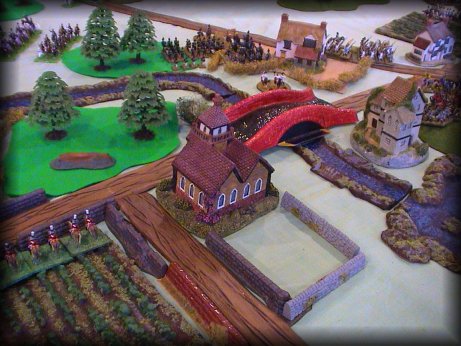 The
commanders’ briefings for the coming battle were both instructive, and set
the tone for what was to come. Napoleon,
having pulled the Reserve Cavalry off his left flank to give him superiority
in the centre succumbed to his fears of a flank attack again and ordered the
best part of them, the heavies, back to that flank to support the Saxons. He
did however order the separated part of the Saxon foot to rejoin their
colleagues and these, with the Imperial Guard, would allow him to attack
through Bullenkopf. The French
and Polish line infantry, supported by the dragoon division was expected to
hold the wooded heights on both sides of the valley and the right flank
beyond. The good part of this
plan was that the Emperor had sorted out all of his corps so that they could
fight together as cohesive units. The
bad part was that the Reserve Cavalry would be wasted for most of the battle
whilst the line infantry on the right was perilously weak for the task
allotted to it. The
commanders’ briefings for the coming battle were both instructive, and set
the tone for what was to come. Napoleon,
having pulled the Reserve Cavalry off his left flank to give him superiority
in the centre succumbed to his fears of a flank attack again and ordered the
best part of them, the heavies, back to that flank to support the Saxons. He
did however order the separated part of the Saxon foot to rejoin their
colleagues and these, with the Imperial Guard, would allow him to attack
through Bullenkopf. The French
and Polish line infantry, supported by the dragoon division was expected to
hold the wooded heights on both sides of the valley and the right flank
beyond. The good part of this
plan was that the Emperor had sorted out all of his corps so that they could
fight together as cohesive units. The
bad part was that the Reserve Cavalry would be wasted for most of the battle
whilst the line infantry on the right was perilously weak for the task
allotted to it.
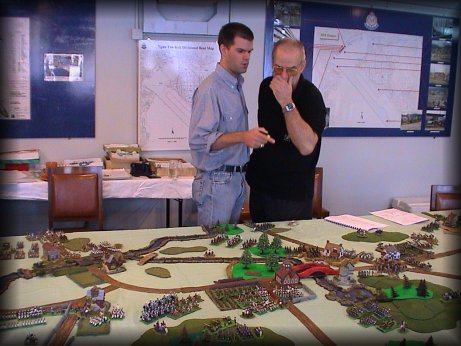 “On
the other side of the hill” Charles immediately withdrew the units off the
battlefield to his right: the grenadier division and two-thirds of another
infantry division, and pulled them back behind his centre, still concealed
but able to intervene at short notice. Since
Napoleon was to commit his best cavalry to meet a non-existent threat from
these troops it is clear that the Archduke had pulled off a successful
tactical deception. The question
was could he capitalise on it? His plan was to put pressure on the French
right and centre until something cracked and then exploit with the off field
forces. The only problem with
this was that nothing was done to sort out the intermingling and stretching
out of the corps. As a result
the individual divisions would fight largely separate battles instead of
delivering coordinated and sustained blows against the French. “On
the other side of the hill” Charles immediately withdrew the units off the
battlefield to his right: the grenadier division and two-thirds of another
infantry division, and pulled them back behind his centre, still concealed
but able to intervene at short notice. Since
Napoleon was to commit his best cavalry to meet a non-existent threat from
these troops it is clear that the Archduke had pulled off a successful
tactical deception. The question
was could he capitalise on it? His plan was to put pressure on the French
right and centre until something cracked and then exploit with the off field
forces. The only problem with
this was that nothing was done to sort out the intermingling and stretching
out of the corps. As a result
the individual divisions would fight largely separate battles instead of
delivering coordinated and sustained blows against the French.
The
battle opened with a cavalry clash in the central valley. To
give himself room to manoeuvre the Emperor sent forward a dragoon brigade. This
was to have been met by four regiments of Austrian light cavalry. But,
it being too early in the morning and not having had their schnapps yet,
half of these refused to charge and their comrades who did charge were very
roughly handled, with the French dragoons breaking through to ride down some
of the Austrian infantry coming up behind. The
remainder of the Austrian light horse woke up and a regiment of cuirassiers
was committed to stabilize the situation. The
French threw in the second brigade of the dragoon division and by
10AM
the honours were roughly equal. The
Austrian cavalry had received a bloody nose, and its pride was certainly
hurt, but the regiments had not suffered major damage. French losses had
been similar to the Austrians but with smaller, less robust regiments they
felt the effects more. As the
dust cleared however it was clear that the leadership on both sides had been
in the finest tradition of the cavalry: and that they had paid the ultimate
price with one French and two Austrian brigadiers dead. Since
both the Austrians were from the Reserve Cavalry division, that unit, which
should have been the Allies’ main striking force, suffered from sluggish
command for the rest of the battle.
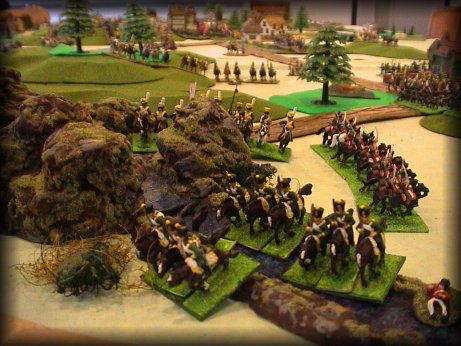 On
the French far right their only light cavalry brigade was probing forward
across a stream towards the wooded heights that formed the side of the
central valley. Here the leading
regiment of Polish lancers came face to face with the last uncommitted
Austrian cavalry unit: more cuirassiers! The
Emperor had made it clear that he expected the Poles to charge. The
odds of taking out the cuirassiers were indeed long, but if it could be done
then the way to the Austrian rear was open. The
Polish commander assessed the task given him, no doubt he thought back to
the
Pass
of
Somosierra
where, in 1808, Napoleon had sacrificed another Polish
light horse regiment for no gain. The
Emperor had been wrong then, maybe this time he was right. In
circumstances like these there was only one thing for a Pole to do. He
shrugged his shoulders, then straightened his back, drew his sabre and
shouted charge over his shoulder… Twenty minutes later the Poles and
another chasseur regiment of the brigade were back over the French side of
the stream, broken, blown and vowing never again to let a Corsican
artilleryman tell Polish lancers how to do their business. Much
chastened the light cavalry withdrew behind their infantry to regroup, minus
the chasseurs who arrived at
Leipzig
three hours later claiming that they were the only
survivors of the Emperor’s defeat! On
the French far right their only light cavalry brigade was probing forward
across a stream towards the wooded heights that formed the side of the
central valley. Here the leading
regiment of Polish lancers came face to face with the last uncommitted
Austrian cavalry unit: more cuirassiers! The
Emperor had made it clear that he expected the Poles to charge. The
odds of taking out the cuirassiers were indeed long, but if it could be done
then the way to the Austrian rear was open. The
Polish commander assessed the task given him, no doubt he thought back to
the
Pass
of
Somosierra
where, in 1808, Napoleon had sacrificed another Polish
light horse regiment for no gain. The
Emperor had been wrong then, maybe this time he was right. In
circumstances like these there was only one thing for a Pole to do. He
shrugged his shoulders, then straightened his back, drew his sabre and
shouted charge over his shoulder… Twenty minutes later the Poles and
another chasseur regiment of the brigade were back over the French side of
the stream, broken, blown and vowing never again to let a Corsican
artilleryman tell Polish lancers how to do their business. Much
chastened the light cavalry withdrew behind their infantry to regroup, minus
the chasseurs who arrived at
Leipzig
three hours later claiming that they were the only
survivors of the Emperor’s defeat!
Meanwhile
Charles had thrown a whole division into the wooded heights on the other
side of the valley next to Bullenkopf. This
allowed the Austrians to position artillery on both sides of the valley into
which the French dragoon division again came forward. The
Emperor expected the Polish infantry to support the dragoons on their right
but since the Poles were already facing an equal number of Prussians, with
more arriving on the flank, this was quite unrealistic. As
a result the dragoons were caught in crossfire facing a solid line of
Austrian horse. One dragoon
regiment was destroyed and the others withdrew behind the French centre to
lick their wounds.
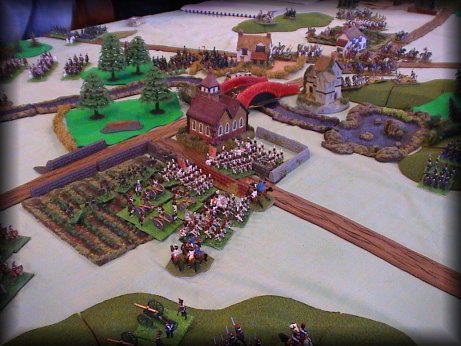 At
Bullenkopf the Imperial Guard and the Saxons came forward to be met by the
second Prussian division in close fighting amongst the villages and woods
where both sides gave as good as they got. The
French positioned “The Emperor’s beautiful daughters”, the 12 pounders
of the Guard Artillery, on the open hill to the left to dominate a swath of
the battlefield. The gunners
amused themselves by demolishing any enemy batteries that deployed in range
and flattening some of the Prussian occupied buildings. But
although the 12 pounders’ firepower was dangerous their major effect was
to create a vacuum swept by fire to the left of the Prussians that extended
all of the way to the Allied right where the Saxons and the Austrians had
been sparring all morning. At
Bullenkopf the Imperial Guard and the Saxons came forward to be met by the
second Prussian division in close fighting amongst the villages and woods
where both sides gave as good as they got. The
French positioned “The Emperor’s beautiful daughters”, the 12 pounders
of the Guard Artillery, on the open hill to the left to dominate a swath of
the battlefield. The gunners
amused themselves by demolishing any enemy batteries that deployed in range
and flattening some of the Prussian occupied buildings. But
although the 12 pounders’ firepower was dangerous their major effect was
to create a vacuum swept by fire to the left of the Prussians that extended
all of the way to the Allied right where the Saxons and the Austrians had
been sparring all morning.
It
was into this vacuum that, at just before
noon
, came the best cavalry in
Europe
: the Saxon light horse leading with their heavies
behind, supported by dense columns of infantry. With
the Guard Artillery masked at last the Allies threw forward their only
cavalry in the area, a rather mediocre Prussian brigade, to stall for time.
A regiment each of Saxon and Prussian light horse met in a swirling melee of
men, horses and German expletives. The
Prussians had numbers the Saxons had élan. The
whole battlefield seemed to hold its breath as the light horsemen fought
each other to the finish and, at the very last moment, God sided with the
big battalions. The Saxon
brigadier went down wounded and the Prussians were left very battered but
still holding their ground. With
two larger and better brigades the Saxons could easily shrug off the loss of
one regiment but, as the Emperor often said, you can replace men, you can
recover ground, but you can never regain lost time. As
the cavalry were fighting it out the Austrians and Prussians had been able
to realign their forces in the centre and their right, bringing up infantry
and artillery, including the heavies from the Grenadier division. Their
job done the Prussian cavalry withdrew behind this new line. With
cannon and foot in good defensive positions to the front and either side it
was clear that the Saxon cavalry would not break through. For
a while there was a disaster in the offing as the horsemen faced artillery
fire from three directions at once, but the Allied gunners were off their
aim and the Saxons successfully withdrew.
Meanwhile
on the French right the Prussians were using their numbers to good advantage
against the Poles holding the wooded heights. Their
first effort was a crude attempt to clear the hill by brute force as the
Landwehr regiment sent a battalion forward in column against the Poles in
line. However the Poles were not
to be intimidated by Prussians. The
line stood firm and rolling volleys stopped the column dead and then sent it
reeling back into the woods. After
this setback the Prussians adopted a more scientific approach and summonsed
up an Austrian cuirassier regiment and a horse battery to set about
destroying the Polish infantry. With
three brigades plus cavalry support against two, it was a simple matter for
the cuirassiers to force the Poles into squares which the artillery and
infantry would then demolish. Whilst
this was going on the Austrian Grenadiers were brought into the central
valley to take out the French centre and the final two brigades of Austrian
reserves were brought on behind Bullenkopf.
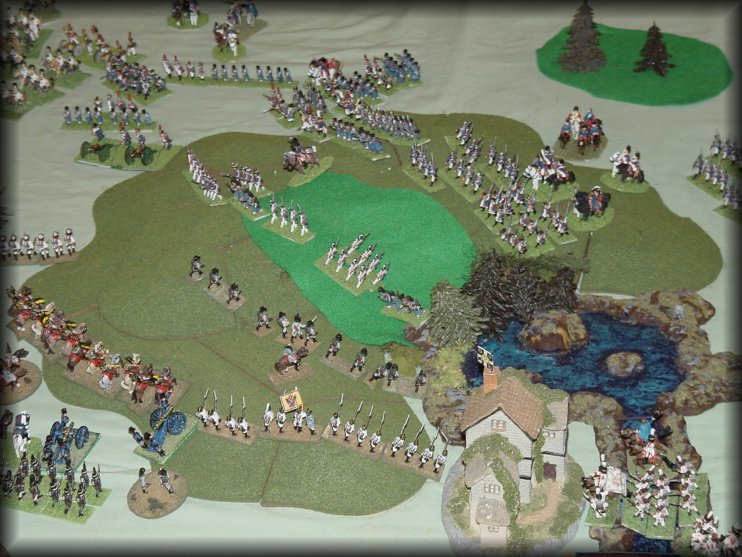 All
in all things were not looking too good for the Emperor but he had been in
this position before more than once and he didn’t give in to his fears. On
his right he closed up the overextended French division to cover the valley
and support the left of the Poles, who were still standing, reeling and
jabbing like punch-drunk boxers. The
least battered dragoon brigade was pulled out of reserve to prop up the
Poles’ right. The struggle to
oust the Austrian division from the wooded heights above Bullenkopf was
taken over by the Imperial Guard where discipline, experience, firepower and
exterior lines were beginning to tell. In
the woods the two brigades of the Austrian division had become inextricably
mixed with their lines so closely packed that French artillery shots would
scythe through several Austrian units. On
the French left the Saxons had been surprised when the Allies had not
followed up their withdrawal. But
taking advantage of this Napoleon now sent all his aides de camp to the left
to summons up the French Reserve heavy cavalry and their Saxon colleagues to
begin a long march to the French right and centre respectively. By
2PM
the battle was set for its climax. All
in all things were not looking too good for the Emperor but he had been in
this position before more than once and he didn’t give in to his fears. On
his right he closed up the overextended French division to cover the valley
and support the left of the Poles, who were still standing, reeling and
jabbing like punch-drunk boxers. The
least battered dragoon brigade was pulled out of reserve to prop up the
Poles’ right. The struggle to
oust the Austrian division from the wooded heights above Bullenkopf was
taken over by the Imperial Guard where discipline, experience, firepower and
exterior lines were beginning to tell. In
the woods the two brigades of the Austrian division had become inextricably
mixed with their lines so closely packed that French artillery shots would
scythe through several Austrian units. On
the French left the Saxons had been surprised when the Allies had not
followed up their withdrawal. But
taking advantage of this Napoleon now sent all his aides de camp to the left
to summons up the French Reserve heavy cavalry and their Saxon colleagues to
begin a long march to the French right and centre respectively. By
2PM
the battle was set for its climax.
The
Austrian attack in the central valley moved forward professionally with the
Grenadiers screened by light horse. The
French threw out infantry skirmishers to slow them down whilst the line
infantry behind formed square. An
Austrian Hussar regiment charged the presumptuous French skirmishers and
sent them racing back towards the squares. Not
fast enough however because the horseman quickly caught up with the
terrified foot and looked certain to put them to the sword. Normally
skirmishing cavalry have little to fear from the reduced firepower of a
square, but on this occasion both squares held their fire until the last
moment and then each unleashed a devastating volley that brought the Hussars
to a shocked and bloody halt. It
had been close, but the French skirmishers scrambled to safety.
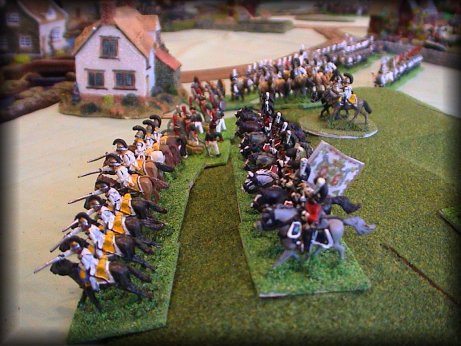 For
the Austrians though this was only a minor set back as the Grenadiers came
up to the French line. The stage
was set for the Austrian skirmishing cavalry to charge the French batteries
and keep them busy whilst at the same time unmasking the Grenadier columns
which would make short work of the French infantry squares. But
it was not to be. The Grenadiers
were fresh and relatively untouched but the Austrian cavalry regiments had
been in action all morning and, despite the possibility of victory in their
grasp, they refused to go forward. The
attack stalled within 200 yards of the French line: the Allied high water
mark. The wily old Grenadier
commander looked around him. From
the French right Saxon heavy cavalry were already arriving. On
the hill above Bullenkopf the Austrian division was falling back in disorder
which meant that the French Imperial Guard would soon be behind his flank. This
was grim. He looked behind him
for reserves. There were none. What
had happened to the promising Austrian position of less than an hour ago? For
the Austrians though this was only a minor set back as the Grenadiers came
up to the French line. The stage
was set for the Austrian skirmishing cavalry to charge the French batteries
and keep them busy whilst at the same time unmasking the Grenadier columns
which would make short work of the French infantry squares. But
it was not to be. The Grenadiers
were fresh and relatively untouched but the Austrian cavalry regiments had
been in action all morning and, despite the possibility of victory in their
grasp, they refused to go forward. The
attack stalled within 200 yards of the French line: the Allied high water
mark. The wily old Grenadier
commander looked around him. From
the French right Saxon heavy cavalry were already arriving. On
the hill above Bullenkopf the Austrian division was falling back in disorder
which meant that the French Imperial Guard would soon be behind his flank. This
was grim. He looked behind him
for reserves. There were none. What
had happened to the promising Austrian position of less than an hour ago?
Had
he not been in the valley the old Grenadier would have seen the trail of
dust moving behind the French centre and would have drawn the right
conclusions. Riding Hell for
leather the French heavy cavalry was moving completely across the
battlefield from the extreme left to the extreme right. The
three mile march took 40 minutes, hastened as it was by Napoleon in person. With
relief on the way the Poles renewed the fight and their last remaining
brigade entered the fray, catching a Prussian regiment in a defile between
the stream and the wooded heights. On
the heights themselves the other Prussian line regiment and the Landwehr
regiment were running out of steam. They
could hold the heights and the woods but not force the thinly held Polish
line on the stream below them. With
both the Poles and the Prussians near the end of their tethers only a slight
increase in force on either side could tip the balance. The
Prussians desperately rushed their cavalry brigade, still battered from its
clash with the Saxons beyond Bullenkopf to support their infantry. At
the same time the commander of the Austrian reserves, an infantry brigade
and a hussar brigade, did not wait for Charles’ instructions and moved on
his own initiative to backstop the Prussians and secure the Allied flank.
A
sort of hush descended on the battlefield as the Austrians and Prussians on
the heights saw the dust cloud thrown up by 3500 horses move up on the
French right. Two heavy brigades
deployed in depth, with regiments of carabiniers and cuirassiers leading,
supported by another brigade of dragoons to protect their flank, thrust
across the stream. Nothing
daunted the Austrian and Prussian light horse descended from the heights to
meet them. The Allies were more
numerous than the two leading French regiments but were completely
outclassed. The Allied cavalry
was bloodily repulsed but at least they had halted the French vanguard. The
French second line of cuirassier regiments would come up soon but by then
the Austrian infantry and the Allied artillery would be firmly ensconced in
the woods and on the heights so that even the best cavalry would not break
through.
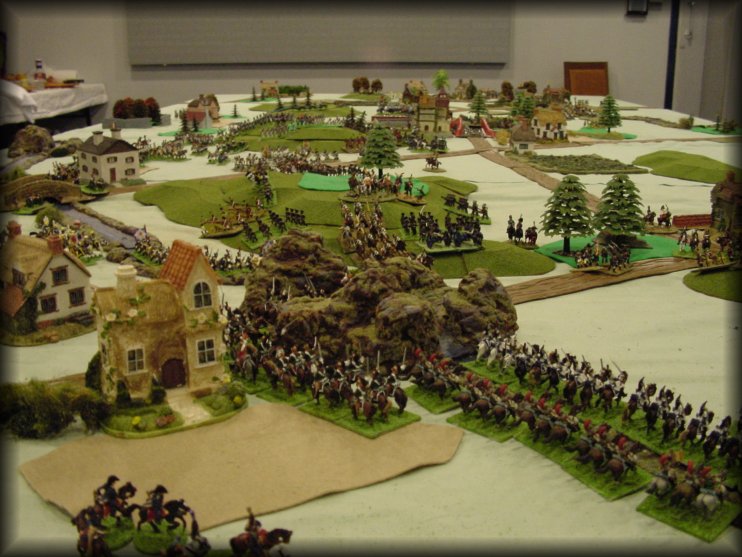 And
there, effectively, the battle ended. As
the heat of the Saxon afternoon bore down, men and horses who had been
fighting since dawn could give no more.
The intervention of the Cavalry Reserve had saved the French right
and pulled off the Allied reserves that could have made the Austrian
Grenadier attack in the central valley decisive.
The corps of Polish and French infantry had been wreaked, but in
return the Prussian line division had been badly battered and the Austrian
division in the woods above Bullenkopf was in dire straits as the Imperial
Guard closed in for the kill. In
this situation withdrawing the Grenadiers from the valley would be
difficult, but not impossible. Although
the Austrian cavalry there had little offensive punch left they could still
cover a rearguard competently. The
Austrians still had two large divisions untouched, one of which even
included a fresh dragoon brigade, but these were now stretched literally
right across the battlefield. Spread
out like this they could hold out in advantageous terrain indefinitely but
they had little offensive value. The
Saxons had handled themselves well and were still largely untouched. Some
units had been knocked about but both the Saxon divisions were still
functioning. And
there, effectively, the battle ended. As
the heat of the Saxon afternoon bore down, men and horses who had been
fighting since dawn could give no more.
The intervention of the Cavalry Reserve had saved the French right
and pulled off the Allied reserves that could have made the Austrian
Grenadier attack in the central valley decisive.
The corps of Polish and French infantry had been wreaked, but in
return the Prussian line division had been badly battered and the Austrian
division in the woods above Bullenkopf was in dire straits as the Imperial
Guard closed in for the kill. In
this situation withdrawing the Grenadiers from the valley would be
difficult, but not impossible. Although
the Austrian cavalry there had little offensive punch left they could still
cover a rearguard competently. The
Austrians still had two large divisions untouched, one of which even
included a fresh dragoon brigade, but these were now stretched literally
right across the battlefield. Spread
out like this they could hold out in advantageous terrain indefinitely but
they had little offensive value. The
Saxons had handled themselves well and were still largely untouched. Some
units had been knocked about but both the Saxon divisions were still
functioning.
And
thus it was that Archduke Charles found himself pulling back before Napoleon
again. In 1809 he had run the
Emperor very close but had been defeated in the end. In
1813 what the soldiers came to call “the slaughter of Bullenkopf”, where
70,000 men fought by accident and achieved no decisive result, had shown was
that the days when the French could hold the rest of
Europe
in contempt had passed. Soon
it would be Germans: Austrians, Prussians, maybe even Saxons who would stand
on the blood soaked field as the French withdrew.
“Saxons”,
thought Charles, “ Saxons… Yes maybe I should get in touch with those
chaps. They should be able to
see the writing on the wall as well as anyone.”
The Game
The
game was set up on a Friday night and played out over the Saturday and
Sunday in Ngau Tau Kok: hence “Bullenkopf”. The
sides were exactly equal in points at 720.5 each. Over
1400 figures were used. The French had quality the Allies quantity, 34,000
men against 42,000, a total of 292 hits against 317. The
table was 12 foot by six foot.
Jeff
was the Emperor, aided by
Adrian
(pun intended) leading the Saxons. The
Poles were handled by Andrzej (naturally) on the first day and Dick on the
second. Neil was the Archduke,
Dieter controlled the Prussians, (and he is bonkers enough to make a
credible Blucher,) whilst James commanded two of the Austrian infantry
divisions. The wily old
Grenadier was yours truly.
The
set up was kriegspieled by using an abstract system to represent the
approaches to the battlefield through which the two commanders deployed
their brigades. This was great
fun for me as the umpire as Jeff and Neil tried feint and counter-feint to
seize vital bits of ground and bamboozle each other. But
they largely succeeded in confusing themselves. If
I did this again I would have them deploy by division, not brigade. It
would be quicker, neater and more historical. However
the system worked well, both commanders liked it and we ended up with a
deployment that was a far cry from the normal “12 inches in” line ups
that we so often see. It also
meant that the troops were deployed in their fighting positions so that when
the rest of the guys arrived on Saturday they were straight into combat …
no time consuming approach marches.
Once
the game got going we averaged one move every 45minutes of play. Not
too bad considering the amount of lead that had to be humped about the
battlefield. Another player on
each side to move toys and make decisions might have speeded things up a bit
but then again the tendency for multiplayer games to degenerate into agonies
of indecision and endless discussion might have been exacerbated.
Jeff
did his best to role-play the Emperor with his powers declining. He
blamed his allies for his setbacks: “I
gave him nine pips and he didn’t support me!” Maintained
the myth of his own infallibility: “I was not hoodwinked!” And was
suitably imperious to both subordinates and opponents alike. Andrzej
for one will not take tactical advice from him again. James
and Adrian maintained a gentlemanly professionalism throughout the
proceedings. Dieter drove Neil
to distraction but such are the perils of coalition warfare. However,
my vote for “man of the match” goes to Dick who was dealt a very weak
hand when he took over his command on the Sunday but played it with
consummate skill. I of course
helped him a bit when I put the pox on the Austrian offensive by saying,
with only a hint of pity, “Well the only thing that will save those light
infantry is two sixes from those squares.” But the look on his face when
the dice obliged made the whole game worthwhile!
Given
the completely equal points values and command this game was always likely
to end in some kind of draw but I must admit I was surprised, and very
pleased, at the shifts and changes that took place. With
attacks, counterattacks, withdrawals and realignments there was a dynamic
and fluid quality about the game that seemed very Napoleonic. For
most of the game it seemed that the allies had the upper hand but their
command and control problems prevented them from exploiting the advantages
that came their way. The French
on the other hand kept their corps together. Therefore
they were better able to recover quickly from setbacks and take advantage of
the opportunities that came up. Thus
what looked like being a winning draw for the Allies ended up as a winning
draw for the French. In a moment
of unbecoming humility the Emperor summed up The Slaughter of Bullenkopf as:
“Not so much a tale of a battle won. More a tale of a battle lost.”
Finally,
a very, very big thank you goes to Jeff and Amy for their superb
hospitality. Alfresco champagne
lunches should be a feature of all wargames and Jeff’s efforts in feeding
and watering the combatants over the weekend were unstinting. Although
for some reason Bullenkopf never got into the history books, for the
participants the catering alone will make it a battle to remember!
back
to napoleonic wars
|